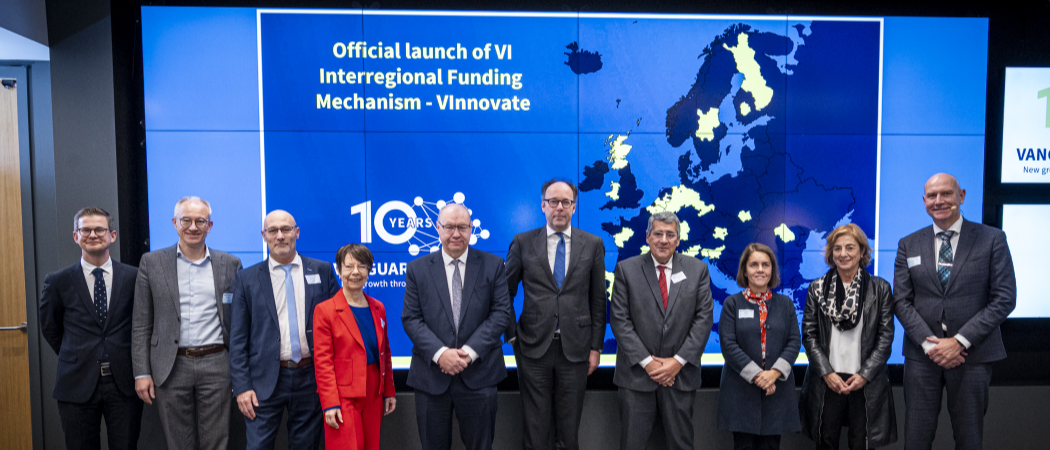The Vanguard Initiative’s new funding instrument aims to strengthen EU innovation ecosystems and support SMEs through regional collaboration and co-investment

The Vanguard Initiative (VI), a network of 38 EU regions, has launched a new funding instrument VInnovate, elevating its efforts to support collaborative innovation across regions, with a focus on small and medium enterprises (SMEs).
Despite the pivotal role SMEs play in Europe’s industry and competitiveness, they often struggle with access to know-how, resources, and funding. VI addresses these challenges through knowledge sharing, collaborations, and grants.
“VInnovate adds an investment element to the initiative,” Michiel Scheffer, the President of the Board of the European Innovation Council, told Science|Business after the launch of the new funding instrument at a conference dedicated to the Vanguard Initiative’s 10th anniversary on December 5 in Brussels. Up until now, VI has mostly focused on networking and helping members secure EU funding, for example, through the Interregional Innovation Investments (I3) Instrument.
The VI’s new funding instrument is designed to be “a common pot” in which regions put money to invest in pilot projects. Scheffer noted that by deciding on priorities together, regions can avoid duplication of efforts.
Using a four-step methodology (learn, connect, demonstrate, and commercialise) to help companies implement their ideas and launch new products, VI supports pilot projects in eight thematic areas: bio-economy, efficient sustainable manufacturing, high-performance production through 3D-printing, advanced manufacturing for energy-related applications in harsh environments, new nano-enabled products, artificial intelligence, smart health and personalised medicine, and hydrogen.
The “eight pilots for the initiative are very well chosen,” said Kris Peeters, vice-president of the European Investment Bank (EIB) and VI co-founder back in 2013. “When we started, we had a clear vision of connecting ecosystems, stimulating inter-regional innovation instruments, and supporting the uptake of new products in Europe,” Peeters told Science|Business. He stressed that most innovations in Europe are in the early stages and come from SMEs, universities, and start-ups.
Geographic expansion continues
Over ten years, the VI network has expanded from six to 38 members. Peeters expects the growth to continue, with more regions and SMEs joining the initiative in the coming years. For Peeters, VI is aligned with wider EU efforts to create more connected and efficient ecosystems across Europe and serves as an additional instrument to achieve EU goals.
Peeters stressed the role regions play in driving innovation. “At the regional level, we have many opportunities to stimulate industrial innovation, and make a difference at the political and economic levels,” he said.
At the 10th anniversary conference, Scheffer described the Vanguard Initiative as “one of the most sizeable action-oriented networks in Europe,” noting that VI concentrates on the development of processes to bring new products to the market.
Scheffer said that VI is aligned with the Regional Innovation Valley (RIV) programme, which aims to connect innovation players across Europe and advance European innovation ecosystems. However, while RIV primarily focuses on coordinating regional efforts, VI now provides funding, in addition to networking opportunities.
Finally, Scheffer stressed the initiative’s role in addressing skills gaps and rethinking European industry. “It’s urgent that we use start-ups to reindustrialise Europe, and the Vanguard Initiative is one of the solutions,” he concluded.
In line with EU goals
Achieving industrial revival is among Europe’s core goals, along with reducing reliance on fossil fuels, increasing food security, and tackling digital transformation.
Delivering a speech at the anniversary conference, Marc Lemaitre, DG RTD Director General, called on Europe to move beyond a focus on policies and develop its own technology. In this context, initiatives to build European innovation ecosystems play a major role.
"The aim is to strengthen European innovation ecosystems that, at the regional level in the medium to long term, will also help overcome the innovation divide by having a mix of less developed and more developed regions participating," he said. Despite the widening programme to narrow the innovation gap between the EU member states, the disparities remain pronounced.
Adopted in 2022, the New European Innovation Agenda is designed to drive tech transformation in Europe by supporting the development and commercialisation of new technologies to address societal challenges.
Lemaitre added that, to become more competitive internationally, Europe should accelerate R&D investments, so that 3% of gross domestic product (GDP) is spent on R&D, compared to the 2.2% recorded in 2022.
Building success stories
As well as supporting the EU’s Innovation Agenda, the new VInnovate funding instrument complements the SME Success Stories support programme launched by VI in 2022 to strengthen the position of promising SMEs and accelerate the adoption of their products. The selected companies – a producer of air purifying products AddCat, a biotech company Remembrane, and a 3-D printing company Bond 3D – have received “an innovation voucher”, a payment of €11,000 to finance interregional collaboration.
The programme has enabled Remembrane to collaborate with a Slovenian-based SME Acies Bio and test its Refeed product designed to boost key performance parameters of any kind of cultured cells. Refeed is now commercialised and is used in biomanufacturing, in-vitro testing, and advanced therapies. AddCat has benefited from knowledge and resources to develop 3D metal printed structures and oxidation catalysts for air purification. Finally, Bond 3D has partnered with the University of Oulu to explore the parameters influencing the life expectancy of 3D printed products.
The launch of VInnovate empowers VI to widen the scope of interregional collaborations. With the new tool, VI members will decide on the use of regional funds, set the scope of projects, and manage and evaluate them. Moreover, SMEs financing can now be adapted to specific regional needs and wider EU objectives, ultimately contributing to the revitalisation of the European industry.


 A unique international forum for public research organisations and companies to connect their external engagement with strategic interests around their R&D system.
A unique international forum for public research organisations and companies to connect their external engagement with strategic interests around their R&D system.